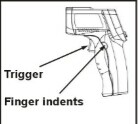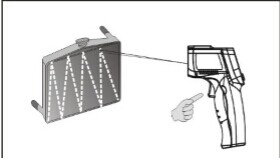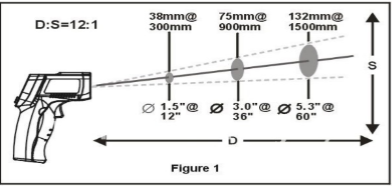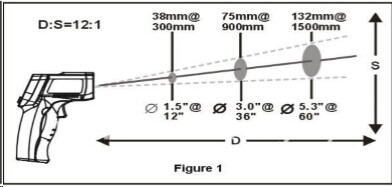A. Introduction
This infrared thermometer is used for measuring the temperature of the object's surface, which is applicable for various hot, hazardous of hard-to-reach objects without contact safely and quickly.
This unit consist of Optics, Temperature sensor signal amplifier, processing circuit and LCD display. The optics collected the infrared energy emitted by object and focus onto the sensor. Then the sensor translates the energy into an electricity signal. This signal will be turned out to be digital shown on the LCD after the signal amplifier and processing circuit.
B. Functions:
1. Celsius / Fahrenheit switchable
2. Equipped with a laser for aiming
3. Temperature hold
4. LCD backlight
5. 20 seconds auto power off
6. Light weight and easy operation
C. Specification
|
Temperature Range
|
-50°C~380°C(-58°F~716°F)
|
|
Accuracy
|
*0°C~380°C(32°F~716°F): ±1.5°C(±2.7°F) or±1.5%
*-50°C~0°C(-58°F~32°F): ±3°C(±5°F)
Whichever is greater
|
|
Resolution
|
0.1°C or 0.1°F
|
|
Repeatability
|
1% of reading or 1 °C
|
|
Response time
|
500 mSec, 95% response
|
|
Spectral response
|
8~14 um
|
|
Emissivity
|
0.95 Preset
|
|
Distance to Spot size
|
12:1
|
|
Operating Temperature
|
0°C~40°C(32°F~104°F)
|
|
Operating Humidity
|
10~95% RH non-condensing up to 30°C(86°F)
|
|
Storage Temperature
|
-20~60°C(-4°F~140°F)
|
|
Power
|
9V battery
|
|
Typical battery life
|
Non-laser mode: 22 hrs;
Laser mode: 12 hrs
|
|
|
|
|
Dimension
|
153x101x43mm
|
D. Operating instructions
a. Operating the unit

b. Locating a hot spot

c. Distance to spot size
When take measurement, pay attention to the Distance to spot size. As the Distance (D) from the target surface increases, the spot size (S) of the area measured by the unit becomes larger.
*****This unit is equipped with a laser, which is used for aiming.

Make sure the target is larger than the unit's spot size. The smaller the target the closer measure distance. When accuracy is critical, make sure the target is at least twice as large as the spot sise.
d. About the Emissivity:
Most organic materials and painted or oxidized surfaces have an emissivity of 0.95 (pre-set in the unit). Inaccurate readings will result from measuring shiny of polished metal surfaces. To compensate, cover the target surface with masking tape or flat black paint. Measure the tape or painted surface when the tape of painted reach the same temperature as the material underneath.

Please attention if you have interests:
1. How do I use my infrared thermometer?
While there are many different shapes and styles of handheld infrared thermometers, and many features available, the basic function is very similar in very nearly every variation. The first step in taking a measurement, is determining the desired target. All portable infrared laser thermometers regardless of design will have a means of "aiming" the instrument at the target. Some versions simply are shaped in such a way that pointing at the target is the targeting method. Others have a guide such as a laser spot, or group of laser spots that indicate the area being targeted. The temperature measurement is taken when the "trigger" is activated. This is usually a button located eigher underneath the pyrometer (gun style), or on top (television remote control style). The accuracy of the measurement depends on several factors.
2. How do infrared thermometers work?
All matter- liquid, solid, or gas--constantly exchanges thermal energy in the form of electromagnetic radiation with its surroundings. If there is a temperature difference between the object in question and its surroundings, there will be a net energy transfer in the form of heat. This means that a colder object will be warmed at the expense of its surroundings, and a warmer object cooled. If the object in question is at the same temperature as its surrounding, the net radiation energy exchange will be zero. Infrared thermometers take advantage of this "radiation dependence" on temperature to produce a value for the targeted object and displays the results for the operator to read.
3. What is the distance to spot ratio?
D/S Ratio-Distance to Spot ratio refers to a very important feature of your infrared thermometer. This ratio is the size of the area being evaluated by the infrared thermometer as it relates to distance. In other words, the area being measured becomes larger as the distance increases. This has a profound impact on the accuracy or precision of the reading. If the target you are measuring is 6 inches in size, and your infrared thermometer has a D/S ratio of 8:1, than the maximum distance you can reliably measure the temperature of the target is 48 inches. Beyond this distance, not only is the target being measured, but whatever else falls within the "spot" is being measured as well. This means that if a very hot object is the target, and it is in cooler surroundings, than measurements taken beyond the maximun distance will include cooler elements, and lowering the "average" of what is in the "spot".
You need to log in to view the content,
Click here to login
Sorry,No related products.
